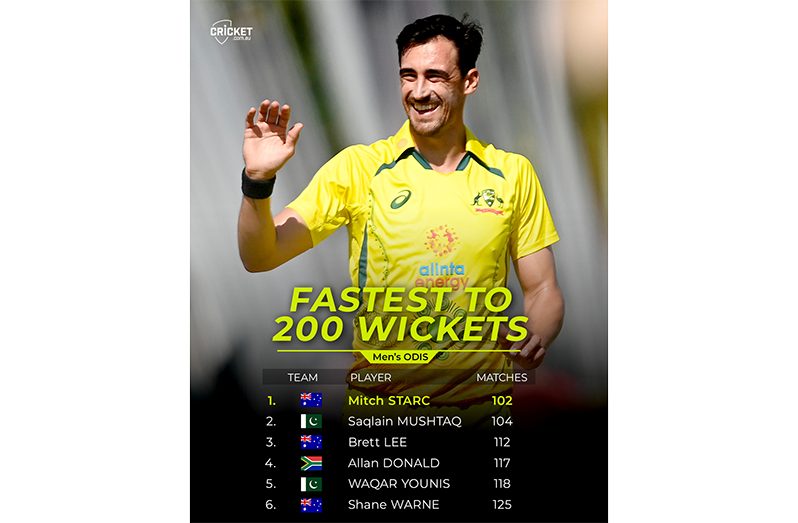MITCHELL Starc has become the quickest-ever bowler to 200 one-day international wickets, eclipsing a 23-year benchmark set by off-spinner Saqlain Mushtaq.
In his 102nd ODI on Saturday in Townsville, Starc dismissed Ryan Burl when he spooned at catch to Cameron Green at mid-off to reach 200 scalps in two fewer matches than the Pakistani great (104).
The 32-year-old’s latest feat only adds to the case for him to be considered the greatest white-ball bowler Australia has ever had, reaching the double-century in fewer matches than Brett Lee (who took 112 ODIs), Shane Warne (125), Mitchell Johnson (129) and Glenn McGrath (133).
Of those Australians, only McGrath (22.02) has a better ODI bowling average than Starc (22.30 after the wicket of Burl) while none has a better strike-rate than his 26.20.
Back in 2016, Starc was also the quickest ever to 100 ODI wickets (after 52 matches), although that mark was bettered in 2018 when Afghanistan spinner Rashid incredibly got there in eight fewer matches
The left-arm quick has spent over 12 months stuck in the 190s such is the lack of ODI cricket he has played of late.
After putting himself within five wickets of 200 with a dominant 11-wicket ODI campaign against the West Indies in July 2021, he looked set to steam past the figure against Sri Lanka in June this year.
However, a freak injury, in which Starc sliced the tip of his left index finger on his bowling spikes in the preceding T20 campaign, meant he did not play a single match of the five-game series.
In an interview with cricket.com.au just prior to that series, Starc was reminded of how close he was to the record and explained that prior experience has taught him he was better off not knowing
“The last time we were talking about this I think I had had to get like a certain number of wickets in a couple games in the West Indies,” Starc said, referring to him arriving in the Caribbean for a 2016 tri-series when he was 10 shy of 100 scalps.
“I just didn’t want to think about it.
“I remember Josh (Hazlewood) and Beaks (team physio David Beakley) were on my back about it for a few games in a row. Once I was past 100, I was like ‘All right, we don’t have to talk about it anymore’.”
On individual honours, he remained philosophical.
“It’s always something that’s nice to look back on when you’re done.
“I like to think that I’ve probably got a few more wickets left in me hopefully.
“I’ve never been about the personal stuff. It’d certainly be probably something to reflect on after cricket.”
Starc has said that one-day cricket was where he first felt at home at the highest level
He made his international debut in the 50-over format back in 2010 and went on to play in 11 ODIs before his first T20I, all of which took place well before he was a regular in the Test arena.
The longer white-ball format perfectly suits Starc’s unique blend of fast, full in-swingers with the new ball and ability to shift the older ball the other way at the death, particularly from around the wicket to right-handers.
He was integral to Australia’s 2015 home World Cup triumph, where two of his most memorable career performances came; his stunning six-wicket haul in a tense defeat at Eden Park and then his famous opening-over wicket of Brendon McCullum in the final at the MCG
He then broke McGrath’s record for the most wickets at a men’s World Cup when he took 27 scalps at the 2019 tournament, leading the Aussies to a semi-final berth.
“It certainly started out as my best format,” Starc said.
“It’s obviously where I first got a chance in the Australian group and then probably grew from there with a few more responsibilities over the first period of my white-ball career, bowling at the death and then obviously the World Cups in recent times.
“So it was probably my most consistent format for a long time.
“It was probably the first format that I felt like I belonged. It took me a lot longer in Test cricket to feel comfortable or like I belonged in Test cricket with the stop-start (nature of his early Test career).(Cricket.com.au)



.jpg)








